1. Introduction
When we listen to poetry, what factors influence our emotional response? Is it solely the content of the poem, or are there other contributing factors? How do listeners' emotional reactions differ when the poem is recited in their native language versus a second language? Does the rhyme of the poem affect the emotional response of the listener? When appreciating poetry, which factor plays a more significant role: the language (native/second language) or rhyme? Research into these questions may help us understand broader issues, such as the influence of language (semantic, syntactic, phonological, native/foreign) on literary appreciation. To address these questions, it is essential to first review previous studies briefly.
A series of empirical studies has shown that the sounds of poetry (such as vowels, consonants, rhyme, rhyme) are subtly connected to emotions. For example, Hevner [1] conducted experiments to investigate the impact of poetic sound elements (such as meter, vowels/consonants, intonation) on the listener's perception. Auracher [2] discovered that the frequent appearance of plosive sounds correlates with pleasant, high-activation emotions, while nasal sounds often indicate negative, low-activation emotions. This finding was proven to be universal and applicable across all cultures and languages. Johnson-Laird and Oatley [3] focused on the relationship between rhyme (such as meter, rhyme) and specific emotions through psychological experiments, finding that high vowels, fast rhymes, and adjacent rhymes were often associated with positive emotions like happiness, while low vowels, slow rhymes, and distant rhymes tended to correspond with negative emotions like sadness. Theoretical research on sound and emotion can be divided into two camps: one is sound iconicity, which suggests an inherent connection between sound and meaning that is not dependent on experiential learning, the other is sound symbolism, which emphasizes conventional connections between sound and meaning that are learned through experience [2]. However, some researchers have pointed out that "the hypothesis of a direct sound-emotion relationship in poetry, such as based on the frequency of certain phonemes, has not withstood empirical reexamination" [4]. Meanwhile, while reviewing the literature, we also noticed that the relationship between sound and negative emotions remains an area worthy of further exploration [3].
Some empirical studies suggest that there is a close connection between language and emotion. Caldwell-Harris [5] found that vocabulary, phrases, or situations in one's native language more easily elicit strong emotional responses (such as anger, shame, love) than similar content in a foreign language, which may feel more "neutral." For example, studies have shown that people tend to have stronger emotional reactions (such as more intense skin conductance responses) when swearing or expressing love in their native language. Barrett, L. F., Lindquist, K. A., & Gendron, M. proposed the "language-as-context" theory, which argues that language (especially emotion-related words like "anger" or "fear") provides a conceptual framework that helps us classify emotions quickly and reduces misunderstandings [6]. Maria Kraxenberger, Winfried Menninghaus, Anna Roth, and Mathias Scharinger [4] conducted research considering the influence of language and sound on emotion in poetry appreciation. They found that when listening to German poetry recordings, non-German-speaking listeners could accurately perceive the emotional tone of the poem through rhythmic features (such as pitch and speed), while German speakers were more likely to rely on the literal meaning of the text to judge the emotion. While this fascinating study provided valuable insights, it overlooked the role of second languages in poetry appreciation. What would happen if the audience were listening to poetry recited in a second language?
Building on this idea, we raise the following questions: What differences in emotional response do listeners experience when poetry is recited in their native language versus a second language? Under conditions where listeners can understand the poem, which is more influential: the language (native/second language) or the rhyme? These questions warrant further investigation.
We propose four hypotheses regarding these issues:
1. L1/L2 and rhyme both significantly impact the listener's emotions.
2. L1/L2 significantly impact the listener's emotions, but rhyme does not.
3. Rhyme significantly impacts the listener's emotions, but L1/L2 do not.
4. Neither L1/L2 nor rhyme impact the listener's emotions.
To test which hypothesis is correct, we designed an experimental text study. We selected four Chinese poems and four English poems, all with sad emotional content and a "distant + regular" rhyme. For each poem, we created three modified versions: "distant + irregular," "adjacent + regular," and "adjacent + irregular" (the method of modification will be explained later). We invited 32 native Chinese speakers (all university students with good English proficiency) to participate in the experiment. After listening to all versions of the poetry recordings, the participants were asked to rate the emotional tone of the poems. Data analysis revealed that language (L1/L2) had a significant impact on the listeners, while rhyme had almost no effect. This confirmed that hypothesis 2 was correct. At the end of this paper, we will further discuss the reasons behind this phenomenon and the related questions it raises. Exploring these issues will help us better understand the role of native and foreign languages in poetry appreciation—and more broadly, in literary appreciation.
2. Methodology
The experiment testing the impact of rhyme and language on emotion in poetry follows 7 overall steps: identifying the variables, selecting poems, adapting poems, grouping poems, grouping emotions, recording poems, and conducting the experiment. The experiment changes the rhyme distance and rhyme scheme of the Chinese and English poems selected using the same adaptation method, an groups the poems using the material counterbalancing method [7].
2.1. Identifying the variables
As Table 1 shows, the independent variables in this experiment are rhyme and language. Rhyme distance and rhyme scheme are the more detailed variables that were used in the rhyme category. For rhyme distance, distant rhyme and adjacent rhyme were the two options; for rhyme scheme, regular and irregular rhyme were the two options; for language, native language (L1) and secondary language (L2) were the two options. Since the experiment was conducted in China, and the subjects were all Chinese native speakers in university, with English as their second language and a relatively high level of English proficiency, L1 would be Chinese and L2 would be English in this context.
The dependent variables are the type of emotion felt by the subjects and the intensity of emotion felt, which were collected using the survey.
The control variables are the cultural background of the poets of the same language, which was controlled by choosing poems from the same time period and same country, the Chinese poems being all modern poets from mainland China, and the English poems being all English poets from the Romantic time period and England; the length of the poems, which was controlled by choosing poems of short length that had 7-8 lines in total and a word or character count ranging from 45-80 with an average of 60 words or characters per poem; and the emotion originally written by the poet, which was controlled by choosing poems that expressed grief and sadness, which have negative emotional valance.
|
Independent Variables |
Dependent Variables |
Control Variables |
|
Rhyme 1. Rhyme Distance (Distant / Adjacent) 2. Rhyme Scheme (Regular / Irregular) |
Type of Emotion Felt (Grief and Anguish / Sorrow and Sadness/ Calm and Happy/ Excited and Joyful) |
Cultural Background of the Poets of the same language (Time and Space) |
|
Length (short poems) |
||
|
Language (L1: Chinese / L2: English) |
Intensity of Emotion Felt |
Emotion Written - Negative, Sad and Grief |
2.2. Selecting poems
The poetry works selected were four Chinese poems and four English poems that had the same original rhyme (Table 2), which was distant and regular. The Chinese poets were all modern poets from mainland China, and the English poets were all from the Romantic time period and from England. The emotions of the poems were sadness and grief. The Chinese poems are sourced from the book: An Anthology of Modern Chinese Love Poetry [8]; the English poems are sourced from the book: The Penguin Book of Romantic Poetry [9].
|
Chinese work |
English work |
|
|
1 |
《山行》 戴望舒 |
"When We Two Parted" – Lord Byron |
|
2 |
《相思》 冰心 |
"La Belle Dame Sans Merci" – John Keats |
|
3 |
《我不知道风是在哪一个方向吹》 徐志摩 |
"To a Distant Beloved" – Percy Bysshe Shelley |
|
4 |
《月夜听琴》 徐志摩 |
"Love’s Last Adieu" – Lord Byron |
2.3. Adapting poems
The poems were changed from distant to adjacent rhyme by switching the second and third line in each stanza of the poem, which was used by Tsur in empirical studies of rhyme perception [10]. The poems were changed from regular to irregular rhyme by changing the last word of the last line in the first stanza to a word with similar meaning but doesn’t rhyme. If this word wasn’t easy to replace, another word in a similar position would be changed, but this seldom happened. Table 3&4 shows the adapted versions of poems
|
Version |
Rhyme Distance |
Rhyme Scheme |
|
Version 1 |
Distant |
Regular |
|
Version 2 |
Distant |
Irregular |
|
Version 3 |
Adjacent |
Regular |
|
Version 4 |
Adjacent |
Irregular |
|
Version 1: Distant & Regular |
Version 2: Distant & Irregular |
|
When we two parted In silence and tears, Half broken-hearted To sever for years, Pale grew thy cheek and cold, Colder thy kiss; Truly that hour foretold Sorrow to this. |
When we two parted In silence and tears, Half broken-hearted To sever for months, Pale grew thy cheek and cold, Colder thy kiss; Truly that hour foretold Sorrow to this. |
|
Original |
Changed “years” to “months” |
|
Version 1: Distant & Regular |
Version 3: Adjacent & Regular |
|
When we two parted In silence and tears, Half broken-hearted To sever for years, Pale grew thy cheek and cold, Colder thy kiss; Truly that hour foretold Sorrow to this. |
When we two parted Half broken-hearted In silence and tears, To sever for years, Pale grew thy cheek and cold, Truly, that hour foretold Colder thy kiss; Sorrow to this. |
|
Original |
Switch lines 2 and 3 of each stanza |
|
Version 3: Adjacent & Regular |
Version 4: Adjacent & Irregular |
|
When we two parted Half broken-hearted In silence and tears, To sever for years, Pale grew thy cheek and cold, Truly that hour foretold Colder thy kiss; Sorrow to this. |
When we two parted Half broken-hearted In silence and tears, To sever for months, Pale grew thy cheek and cold, Truly that hour foretold Colder thy kiss; Sorrow to this. |
|
Switch lines 2 and 3 of each stanza from original |
Switch lines 2 and 3 of each stanza from original; Changed “years” to “months” |
2.4. Grouping poems
After adapting the poems into 4 versions, each version was placed into a different group, with each group having each of the 4 versions in different poems (Table 5). This material counterbalance method reduces order effects and increases internal validity [7].
|
Experiment Group |
Poem 1 |
Poem 2 |
Poem 3 |
Poem 4 |
|
Group 1 |
Version 1 |
Version 2 |
Version 3 |
Version 4 |
|
Group 2 |
Version 2 |
Version 3 |
Version 4 |
Version 1 |
|
Group 3 |
Version 3 |
Version 4 |
Version 1 |
Version 2 |
|
Group 4 |
Version 4 |
Version 1 |
Version 2 |
Version 3 |
Note: Poem 1 includes one Chinese poem and one English poem, and the same applies to poetry-2, 3, and 4.
2.5. Grouping emotions
Emotions can be grouped by valance, positive or negative, and arousal, high or low according to Russell’s Circumplex Model of Affect [11]. Table 6shows the types of emotion.
|
Arousal/Valance |
High |
Low |
|
Negative |
Grief and Anguish (Emotion 1) |
Sorrow and Sadness (Emotion 2) |
|
Positive |
Excited and Joyful (Emotion 4) |
Calm and Happy (Emotion 3) |
2.6. Recording poems
Because human readings may have interpretation and emotional bias, AI was used to read all of the poems. In order to control the voice and tone of the AI, the Chinese voice “Yunyi” and the English voice “Christopher” were chosen to read all of the Chinese and English poems respectively. The AI text to speech website “Natural Readers” was used to record all of the poems https://www.naturalreaders.com/commercial/
2.7. Conducting the experiment
There were 32 subjects in total, each was a university student in China with Chinese as their native language and English as their second language, but with a high proficiency in English. The 32 subjects were split into 4 groups of 8 and were assigned to Group 1 to 4 of the poem groups. The subjects sat in a classroom and heard the recordings of the 8 poems with the order of a Chinese poem and an English poem alternating, and afterwards filled out a survey about the intensity of each of the 4 emotions in each of the poems.
3. Results
We analyzed the experimental data using SPSS and conducted significance tests. The p-value (significance value) is generally considered significant when p < 0.05. If p < 0.05, the result is significant; if p ≥ 0.05, the result is not significant (Table 7).
The experimental results are shown in the figures 1-16 below: These figures analyze the responses for the "Grief and anguish" category. Figures 1 and 2 compare the data from V1 and V2, V3 and V4, with the independent variable being language (Chinese/English) and rhyme type (regular/irregular), while the control variables are distant rhyme and adjacent rhyme. In Figure 1, the p-value for the rhyme variable is 0.048, and the p-value for the language variable is 0.001, indicating that the language variable has a more significant impact. Similarly, in Figure 2, the language variable has a stronger effect. By observing the changes in the line figures, we can see that when the language shifts from Chinese to English, emotional ratings tend to increase. Following this method of observation for the other figures, we find that in the first two categories (Grief and anguish, Sorrow and sadness), emotional ratings generally increase when the language shifts from Chinese to English; in the third and fourth categories (Calm and happy, Excited and joyful), emotional ratings tend to decrease when the language changes. Overall, the p-value for the language variable is smaller than that for the rhyme variable. Therefore, we can conclude that, in general, the language variable has a stronger influence than the rhyme variable, and the participants tend to perceive the English versions of the recordings as more negative than the Chinese versions.
Emotion 1:Grief and anguish(Figures 1-4)
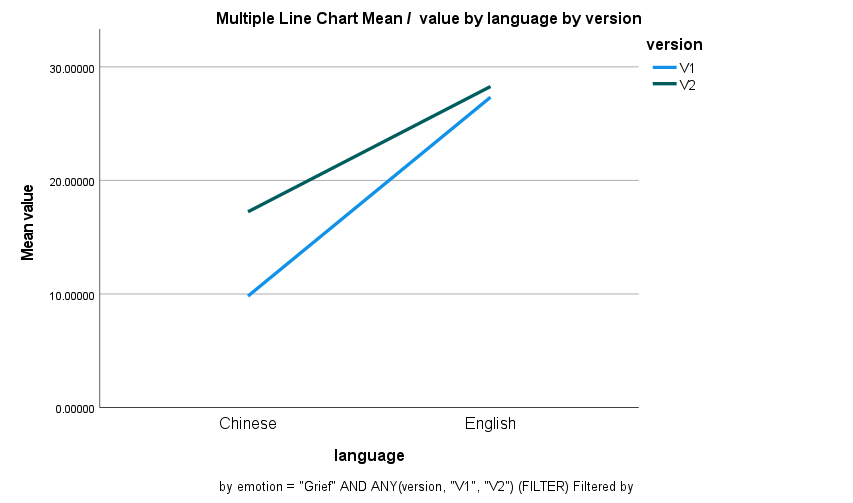
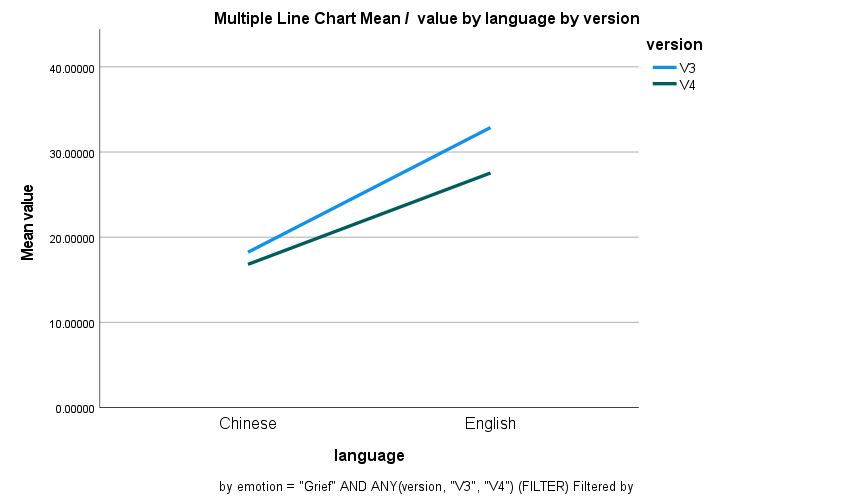
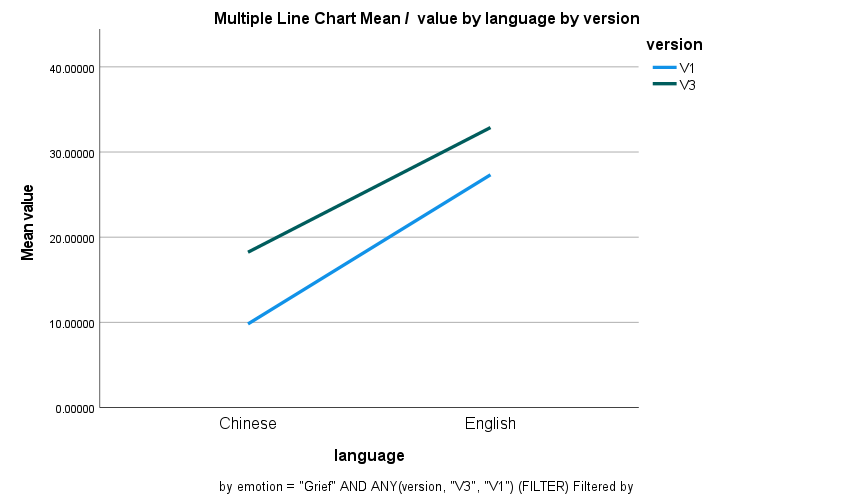
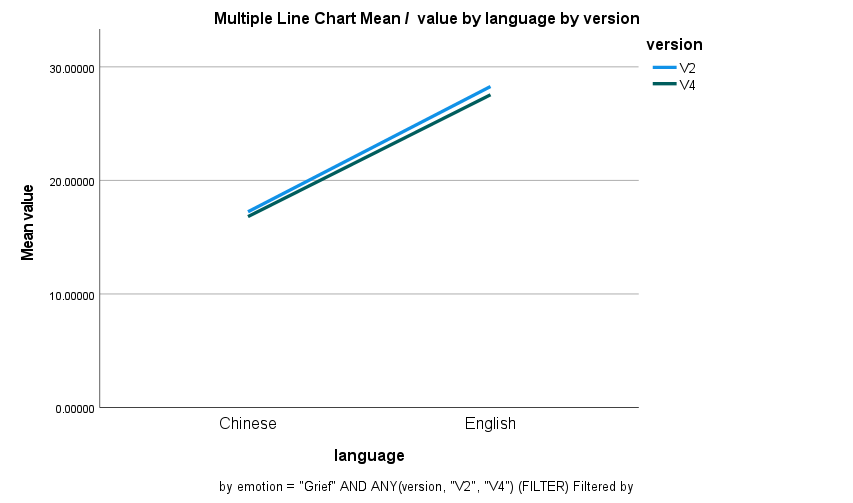
Emotion 2:Sorrow and sadness(Figures 5-8)
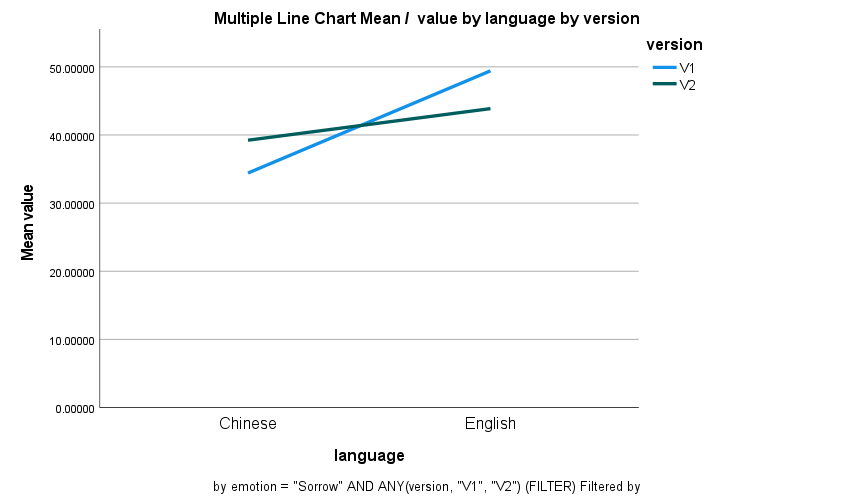
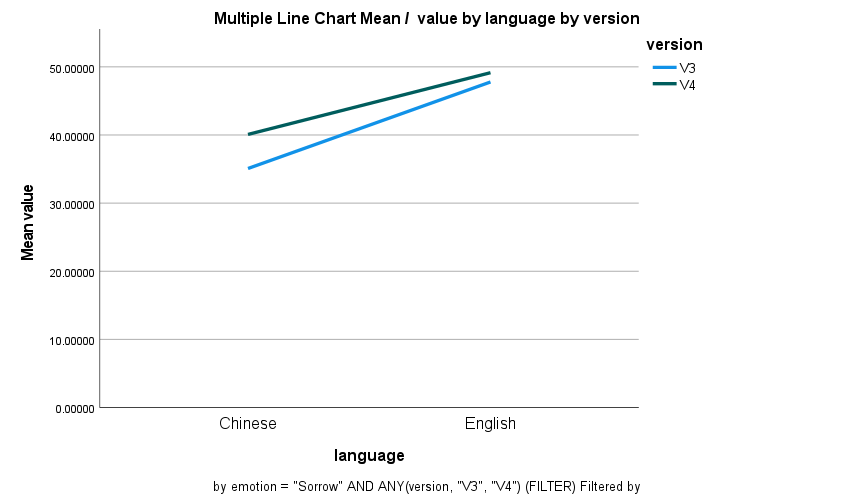
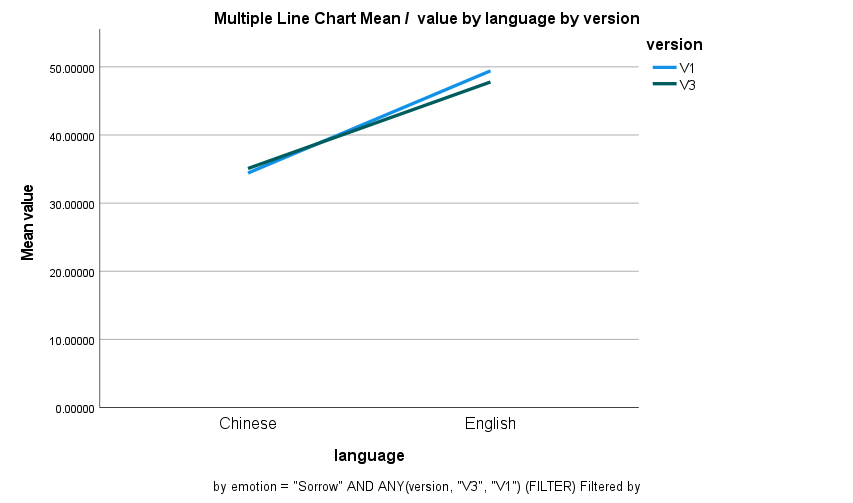
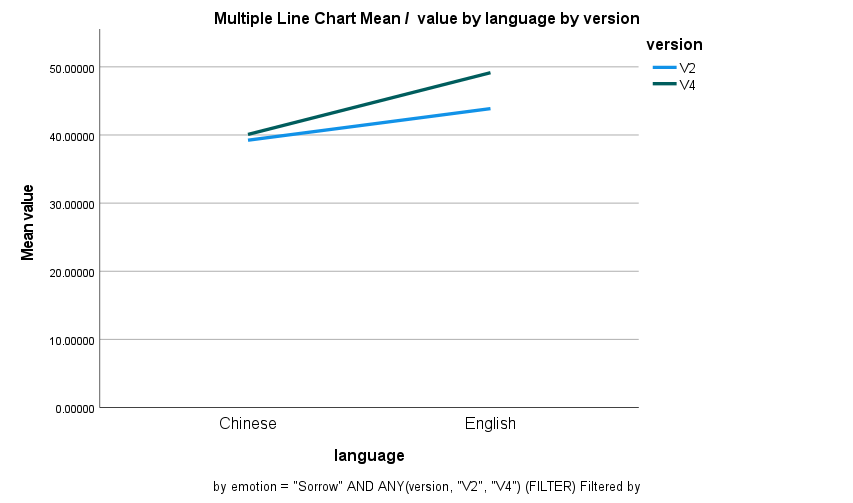
Emotion 3:Calm and happy (Figures 9-12)
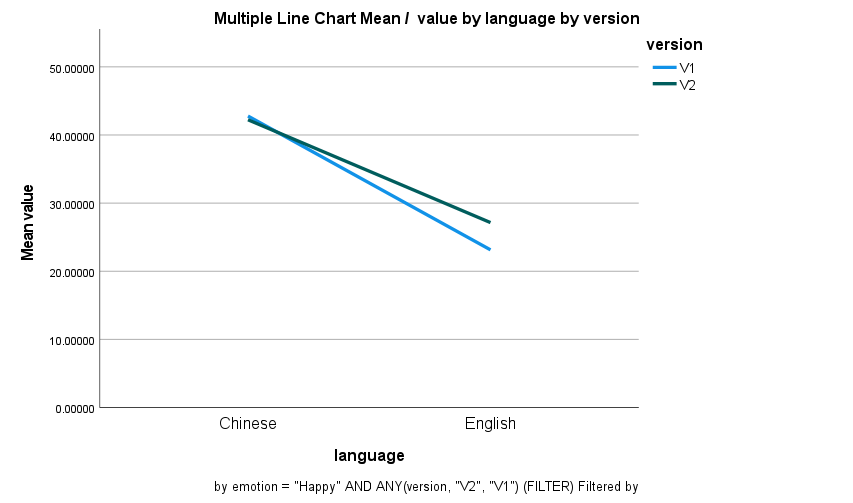
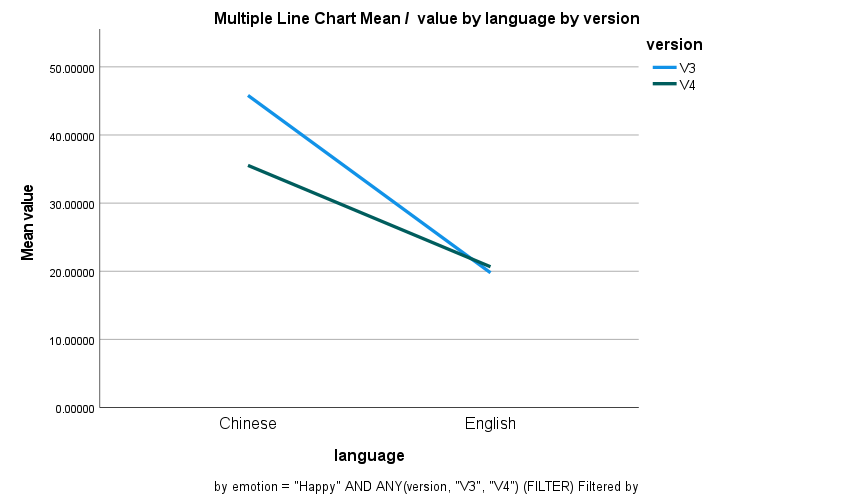
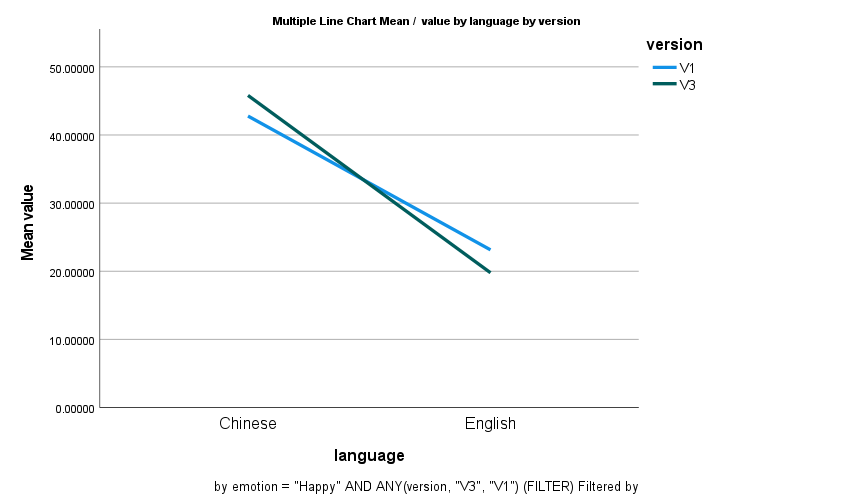
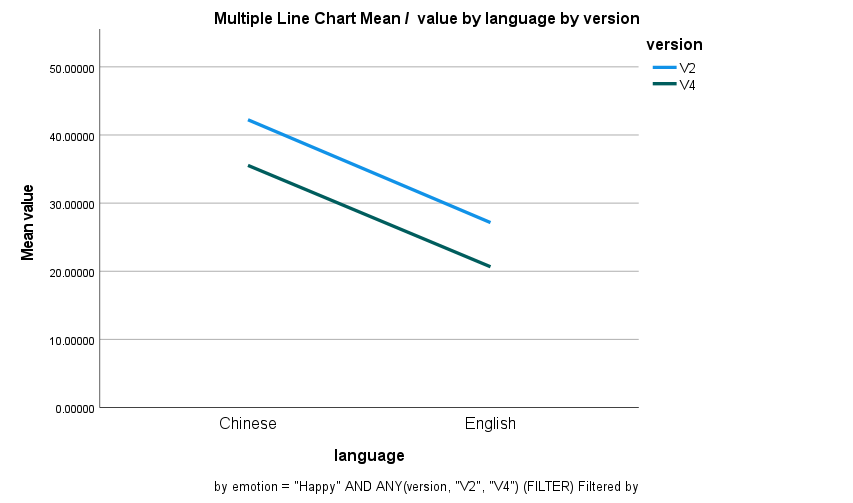
Emotion 4:Excited and joyful (Figures 13-16)
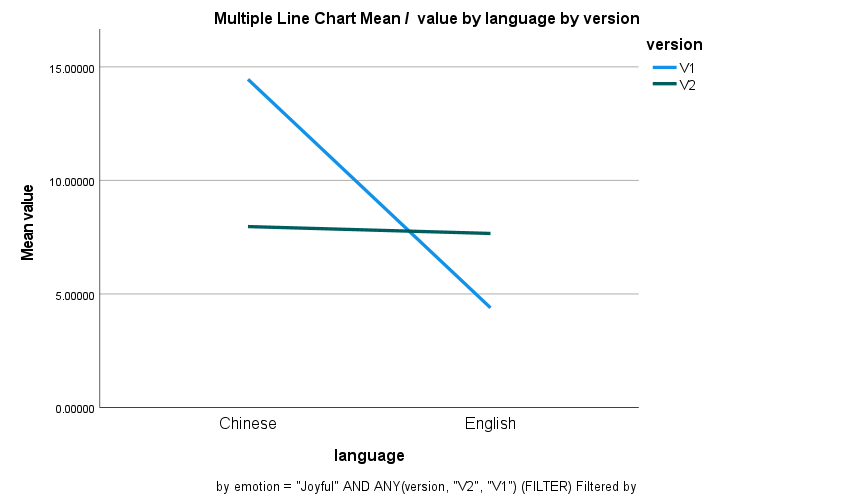
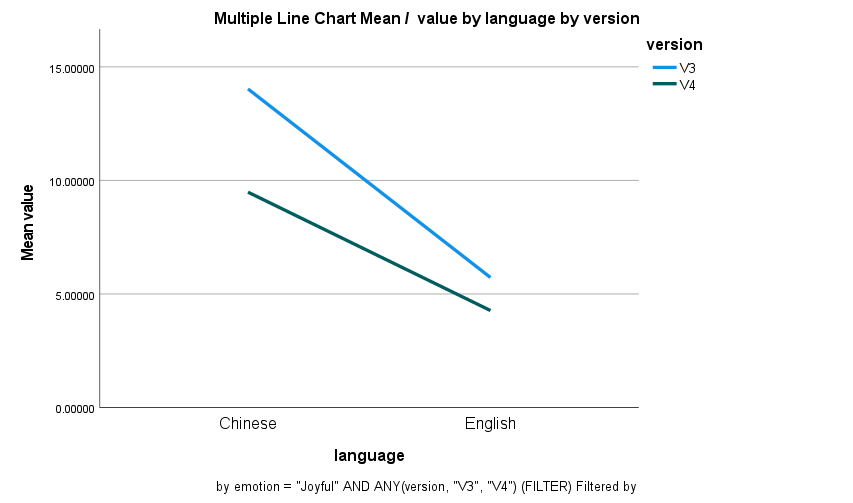
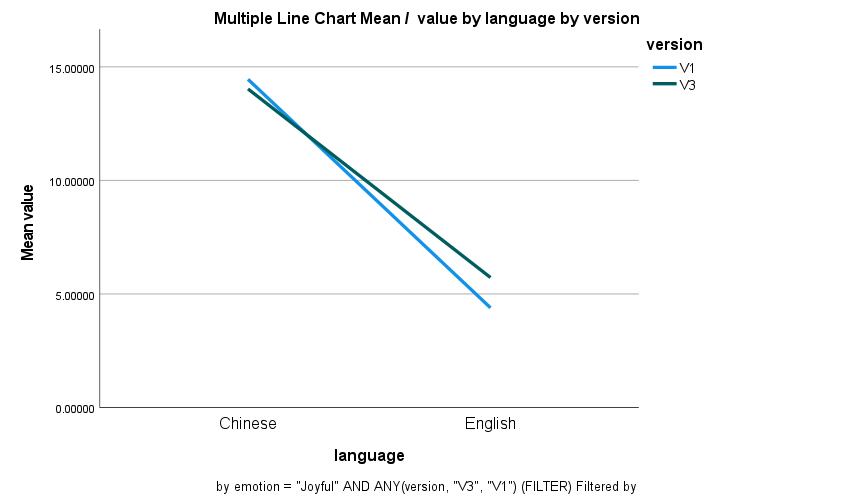
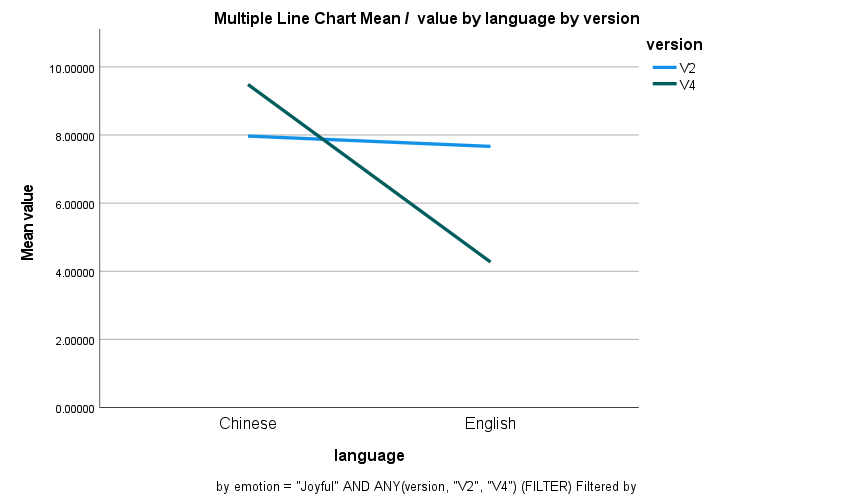
|
p-value |
Distant: V1(regular) & V2(irregular) |
Adjacent: V3(regular) & V4(irregular) |
Regular: V1(distant) & V3(adjacent) |
Irregular: V2(distant) & V4 (adjacent) |
Independent Variables |
|
Grief and anguish |
0.048 |
0.019 |
0.000 |
0.001 |
version |
|
0.001 |
0.000 |
0.000 |
0.000 |
language |
|
|
Sorrow and sadness |
0.889 |
0.018 |
0.419 |
0.039 |
version |
|
0.014 |
0.000 |
0.000 |
0.002 |
language |
|
|
Calm and happy |
0.177 |
0.143 |
0.917 |
0.000 |
version |
|
0.000 |
0.001 |
0.000 |
0.000 |
language |
|
|
Excited and joyful |
0.521 |
0.012 |
0.330 |
0.460 |
version |
|
0.082 |
0.001 |
0.000 |
0.071 |
language |
4. Result
From all the data shown, the intensity of negative emotions interpreted in English poems are higher than the intensity interpreted in Chinese, and the intensity of positive emotions interpreted in English poems are lower than the intensity interpreted in Chinese, which reverse proves that the subjects think that the poems are more sad and grieving in English. The poems chosen all had a negative valance, so the subjects’ interpretation of the emotions in the poems were all correct. But the different rhymes, as shown by the different colored lines, don’t have a consistent impact on the negative emotions, as sometimes the blue line has a higher intensity of negative emotions and sometimes the green line has a higher intensity. Also the p-value of language, 0.001, is much lower than the p-value of rhyme, 0.048, which proves that language has a significant impact on the interpretation of negative emotions, while rhyme does not, proving hypothesis 2 to be true.
5. Reflection and outlook
Although the findings are significant in this research, there are some shortcomings of the experiment that could have impacted the data. First, many subjects said the calm and neutral monotone of AI impacted the way they conceived the poem. But on the other hand, having a human speaker though could bring the speaker’s own interpretation bias into the experiment. This problem is inevitable, but using an AI that is more trained in speaking with emotion could mitigate the problem. Second, there were some practical issues in conducting the offline experiment, such as the sound being small, conducting it in different times of the day, and in different environments, which could have impacted the overall listening experience of the subjects. This could be reduced by conducting the experiment at the same time of the day in multiple near identical professional settings. Third, the method may not have been the most effective in testing the impact of rhyme on the interpretation of the emotions of the poetry, as the subjects did not know to focus on listening to the rhyme instead of the content itself. This could be solved by conducting a contrast experiment where the subjects hear the original poem first and then hear an adapted version, and comparatively rating the emotions based on the differences in rhyme. Lastly, this experiment is constricted to negative emotions, there could be different results in different emotions which could be further researched on.
The reasons for L1/L2 to have a significant impact on the interpretation of negative emotions on poetry and rhyme not having a significant impact are to be further researched, but some explanations are that when listening to L2 literature, subjects focus more on the content instead of the aesthetic, or structural components, because it takes more effort to understand in second language and the subjects prioritize understanding the poem more than the aesthetics, focusing more on the “what” instead of the “how”. Another reason could be that in L1 literature, subjects understand more complex emotions from the poetry, as they can understand figurative devices, such as metaphor, and the nuances in emotions in their native language.
This brings up a new domain of linguistics: foreign language aesthetics appreciation. What is more important to interpretation in foreign languages, the content or the artistic devices? Could this be applied to different forms of narration other than poetry, for example novels, films, music? What makes some works have cross-cultural success and others not? In translation, should the focus be more on preserving the meaning or preserving the artistic devices? Does the level of L2 proficiency affect the interpretation of works? This is a new domain that is yet to be explored and researched on for more answers.
6. Conclusion
This research discusses the effects of rhyme and language on the interpretation of negative emotions in poetry, which in the experiment of 32 subjects listening to variations of poetry recordings read by AI, proved that L1/L2 significantly impacts the listeners’ emotions while rhyme does not. This brings a new domain of linguistics: foreign language aesthetics appreciation, and it is yet to be explored.
Acknowledgement
Yuxiang Chen and Shutian Jiang contributed equally to this work and should be considered co-first authors.
References
[1]. K. Hevner, ‘An Experimental Study of the Affective Value of Sounds in Poetry’, The American Journal of Psychology, vol. 49, no. 3, p. 419, Jul. 1937, doi: 10.2307/1415776.
[2]. J. Auracher, S. Albers, Y. Zhai, G. Gareeva, and T. Stavniychuk, ‘P Is for Happiness, N Is for Sadness: Universals in Sound Iconicity to Detect Emotions in Poetry’, Discourse Processes, vol. 48, no. 1, pp. 1–25, Dec. 2010, doi: 10.1080/01638531003674894.
[3]. P. N. Johnson-Laird and K. Oatley, ‘How poetry evokes emotions’, Acta Psychologica, vol. 224, p. 103506, Apr. 2022, doi: 10.1016/j.actpsy.2022.103506.
[4]. M. Kraxenberger, W. Menninghaus, A. Roth, and M. Scharinger, ‘Prosody-Based Sound-Emotion Associations in Poetry’, Front. Psychol., vol. 9, p. 1284, Jul. 2018, doi: 10.3389/fpsyg.2018.01284.
[5]. C. L. Caldwell-Harris, ‘Emotionality Differences Between a Native and Foreign Language: Implications for Everyday Life’, Curr Dir Psychol Sci, vol. 24, no. 3, pp. 214–219, Jun. 2015, doi: 10.1177/0963721414566268.
[6]. L. F. Barrett, K. A. Lindquist, and M. Gendron, ‘Language as context for the perception of emotion’, Trends in Cognitive Sciences, vol. 11, no. 8, pp. 327–332, Aug. 2007, doi: 10.1016/j.tics.2007.06.003.
[7]. M. Bortolussi and P. Dixon, Psychonarratology: Foundations for the Empirical Study of Literary Response.
[8]. Wang, J. X., Zhang, T. M., Xu, Y. A., & Zhang, S. Z., An anthology of modern Chinese love poetry. Changjiang Literature & Art Press., 1982.
[9]. J. Wordsworth, The Penguin Book of Romantic Poetry. Penguin UK, 2005.
[10]. R. Tsur, ‘Rhyme and Cognitive Poetics’, Poetics Today, vol. 17, no. 1, p. 55, 1996, doi: 10.2307/1773252.
[11]. J. A. Russell, ‘A circumplex model of affect.’, Journal of Personality and Social Psychology, vol. 39, no. 6, pp. 1161–1178, Dec. 1980, doi: 10.1037/h0077714.
Cite this article
Chen,Y.;Jiang,S. (2025). Using a Linguistics Perspective to Analyze Poetry: the Effect of Rhyme and Language on the Interpretation of Negative Emotion in Poetry. Lecture Notes in Education Psychology and Public Media,93,126-139.
Data availability
The datasets used and/or analyzed during the current study will be available from the authors upon reasonable request.
Disclaimer/Publisher's Note
The statements, opinions and data contained in all publications are solely those of the individual author(s) and contributor(s) and not of EWA Publishing and/or the editor(s). EWA Publishing and/or the editor(s) disclaim responsibility for any injury to people or property resulting from any ideas, methods, instructions or products referred to in the content.
About volume
Volume title: Proceedings of ICEIPI 2025 Symposium: Reimagining Society: AI's Role in Cultural Transformation and Learning Environments
© 2024 by the author(s). Licensee EWA Publishing, Oxford, UK. This article is an open access article distributed under the terms and
conditions of the Creative Commons Attribution (CC BY) license. Authors who
publish this series agree to the following terms:
1. Authors retain copyright and grant the series right of first publication with the work simultaneously licensed under a Creative Commons
Attribution License that allows others to share the work with an acknowledgment of the work's authorship and initial publication in this
series.
2. Authors are able to enter into separate, additional contractual arrangements for the non-exclusive distribution of the series's published
version of the work (e.g., post it to an institutional repository or publish it in a book), with an acknowledgment of its initial
publication in this series.
3. Authors are permitted and encouraged to post their work online (e.g., in institutional repositories or on their website) prior to and
during the submission process, as it can lead to productive exchanges, as well as earlier and greater citation of published work (See
Open access policy for details).
References
[1]. K. Hevner, ‘An Experimental Study of the Affective Value of Sounds in Poetry’, The American Journal of Psychology, vol. 49, no. 3, p. 419, Jul. 1937, doi: 10.2307/1415776.
[2]. J. Auracher, S. Albers, Y. Zhai, G. Gareeva, and T. Stavniychuk, ‘P Is for Happiness, N Is for Sadness: Universals in Sound Iconicity to Detect Emotions in Poetry’, Discourse Processes, vol. 48, no. 1, pp. 1–25, Dec. 2010, doi: 10.1080/01638531003674894.
[3]. P. N. Johnson-Laird and K. Oatley, ‘How poetry evokes emotions’, Acta Psychologica, vol. 224, p. 103506, Apr. 2022, doi: 10.1016/j.actpsy.2022.103506.
[4]. M. Kraxenberger, W. Menninghaus, A. Roth, and M. Scharinger, ‘Prosody-Based Sound-Emotion Associations in Poetry’, Front. Psychol., vol. 9, p. 1284, Jul. 2018, doi: 10.3389/fpsyg.2018.01284.
[5]. C. L. Caldwell-Harris, ‘Emotionality Differences Between a Native and Foreign Language: Implications for Everyday Life’, Curr Dir Psychol Sci, vol. 24, no. 3, pp. 214–219, Jun. 2015, doi: 10.1177/0963721414566268.
[6]. L. F. Barrett, K. A. Lindquist, and M. Gendron, ‘Language as context for the perception of emotion’, Trends in Cognitive Sciences, vol. 11, no. 8, pp. 327–332, Aug. 2007, doi: 10.1016/j.tics.2007.06.003.
[7]. M. Bortolussi and P. Dixon, Psychonarratology: Foundations for the Empirical Study of Literary Response.
[8]. Wang, J. X., Zhang, T. M., Xu, Y. A., & Zhang, S. Z., An anthology of modern Chinese love poetry. Changjiang Literature & Art Press., 1982.
[9]. J. Wordsworth, The Penguin Book of Romantic Poetry. Penguin UK, 2005.
[10]. R. Tsur, ‘Rhyme and Cognitive Poetics’, Poetics Today, vol. 17, no. 1, p. 55, 1996, doi: 10.2307/1773252.
[11]. J. A. Russell, ‘A circumplex model of affect.’, Journal of Personality and Social Psychology, vol. 39, no. 6, pp. 1161–1178, Dec. 1980, doi: 10.1037/h0077714.









